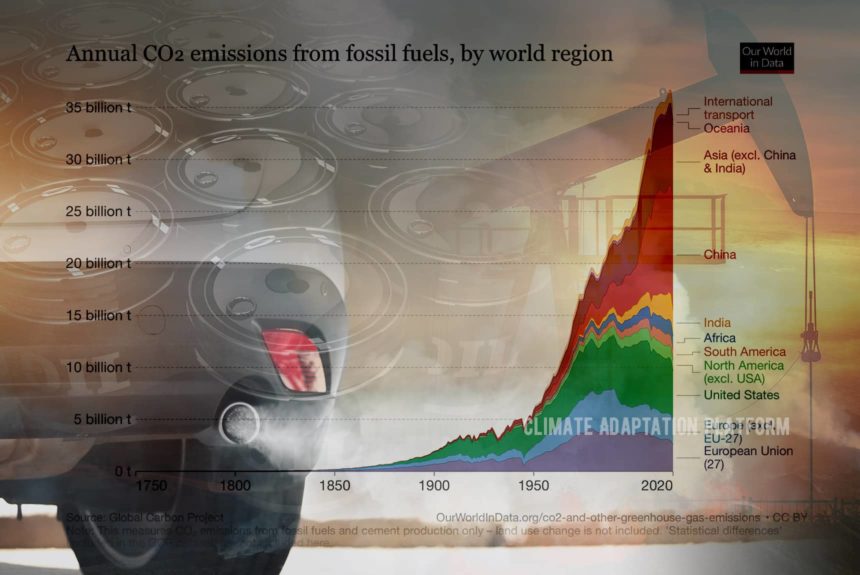Carbon dioxide emissions are the leading cause of climate change. Climate scientists and environmental advocates urgently call for all sectors to reduce emissions to avoid the worst impacts of climate change.
But the share of responsibility regarding climate actions – countries with historically high emissions, currently high emitters, countries with high per capita or total annual emissions, remains a contentious point of international discussions.
Purposes of carbon emissions inventory
Numerous organisations measure emissions by country, capita, region, and sector. These carbon emissions inventories are developed for various purposes.
First to help climate scientists build climate models, and second for policymakers to develop strategies and policies to reduce emissions and track their progress.
The “Our World in Data” website provides information on global historical carbon emissions or emissions before the Industrial Revolution up to the present, emissions from burning of fossil fuels and land-use change, emissions by regions, per capita, and annual emissions per country.
The following are the highlights from the Our World in Data:
- CO2 emissions before the Industrial Revolution is very low until the mid 20th century. In 1950 the world emitted 6 billion tonnes of CO2; by 1990, it had increased four times, reaching more than 22 billion tonnes, and now our annual emission is more than 34 billion tonnes.
- Emissions from fossil fuels and land use have increased since 1850 but have risen rapidly from around the 1940s.
- By region, Europe and the United States dominated the global emissions well into the 20th century.
- In 1900, more than 90% of emissions were produced in Europe or the US; even by 1950, they accounted for more than 85% of emissions each year.
Change in the source of emissions
The recent decades show a significant shift in the sources of emissions. In the second half of the 20th century, a considerable increase in emissions came from the rest of the world, particularly across Asia, most notably, China.
Presently, the United States and Europe only account for just under a third of global emissions.
Per capita emissions show a different picture. Getting a country’s per capita or citizen emission entails dividing its total emission by its population. Emissions are also grouped as production-based and consumption-based.
The IPCC defines production-based emissions as those occurring within the national territory and offshore areas over which the country has jurisdiction.
Consumption-based emissions consider the effects of trade, encompassing the emissions from final domestic consumption and those caused by the production of its imports.
Those with the highest per capita emissions are from major oil-producing countries in the Middle East. In 2017, Qatar had the highest emissions per capita at 49 tonnes; Trinidad and Tobago, 30 tonnes; Kuwait, 25 tonnes; UAE, 25 tonnes; Brunei, 25 tonnes; Bahrain, 23 tonnes; and Saudi Arabia, 19 tonnes.
However, these countries have lower populations, so their total annual emissions per country are minimal.
More populous countries with some of the highest per capita emissions and thus with a high total annual emission include Australia (17 tonnes), the United States (16.2), and Canada (15.6).
In 2017 the per capita emissions of these counties were three times higher than the global average of 4.8 tonnes.
When it comes to annual emissions or the country that emits the most per year, China dominates with nearly 10 billion tonnes of CO2 emissions, accounting for more than a quarter of the global population. The United States follows at 5.3 billion tonnes accounting for 15% of global emissions (Ritchie and Roser, n.d.).
The World Bank website also provides 2018 data on per capita CO2 emissions (CO2 emissions, n.d.).
Measuring and tracking the amounts of carbon emissions of each country or industry is a great tool to see whether climate pledges are kept or whether climate action plans of each country are effective.
Climate change is a global challenge with no borders. Everyone from governments to sectors, companies, and individuals is responsible for reducing their carbon emissions to achieve the Paris Agreement below the 2°C warming limit and hence the catastrophic impacts of climate change.
Source:
Ritchie H. & Roser, M. (n.d.) CO2 emissions. Our World in Data. Retrieved from https://ourworldindata.org/co2-emissions
CO2 emissions (metric tons per capita). The World Bank. Retrieved from https://data.worldbank.org/indicator/EN.ATM.CO2E.PC?end=2018&start=2018&view=bar



Leave a Reply